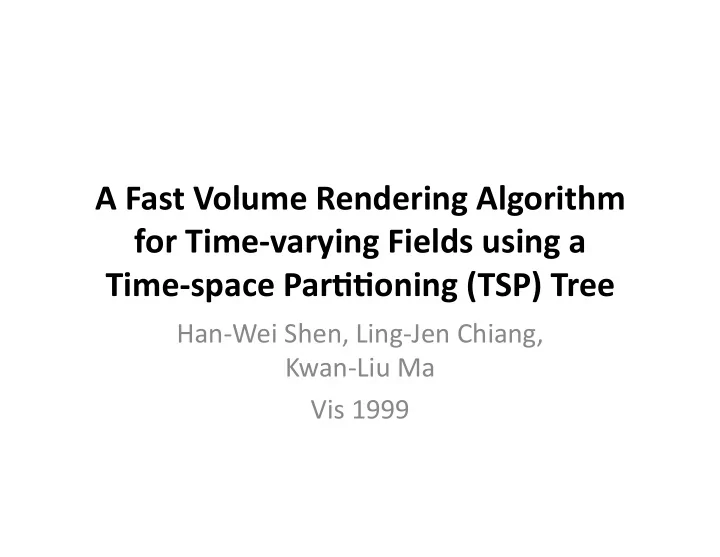

A Fast Volume Rendering Algorithm for Time‐varying Fields using a Time‐space Par<<oning (TSP) Tree Han‐Wei Shen, Ling‐Jen Chiang, Kwan‐Liu Ma Vis 1999
How do we deal with large dataset? • Subdivision – Break big pieces into smaller ones
SpaEal Subdivision • Hierarchy ‐‐ Octree bricks
Add Time… • One Octree per Emestep ? t = 0 t = 1 t = 2 …
Add a Dimension… • 4D tree Octree (8‐tree) ‐> 16 tree ? …
Time‐Space ParEEon Tree • Two Level Hierarchical Subdivision • 1 st level SpaEal subdivision ‐‐ Octree bricks
Time‐Space ParEEon Tree • Temporal Subdivision [0,3] [0,1] [2,3] T= 0 1 2 3 4 <me steps
Rendering • Image composiEon remains the same as an Octree
Temporal Coherence • Images in the octree nodes are cached for nodes with high temporal coherence T = 1 [0,3] [0,1] [2,3] T= 0 1 2 3
Time‐Varying Volume Rendering • Approximate reconstrucEon from the TSP tree E = 0.05 (3.4% image diff.) Error = 0 E = 0.05 (3.4% image diff.) 11.2 speedup
Results • Shock wave: 1024 x 128 x 128 , 40 Eme steps • Minimum brick size 32 x 32 x 32 • Temporal error tolerance = 0.02 Time Step 0 10 20 30 # Bricks Loaded 561 73 75 72 Percentage 100 % 13.0 % 13.3 % 12.8%
Summary • TSP Tree ‐‐ Extend Octree to include temporal informaEon • Render with standard Octree image composiEon • Temporally coherent images are cached to reduce loads • Allow approximated volume rendering animaEon via the hierarchy
Importance‐Driven Time‐Varying Data Visualiza<on Chaoli Wang, Hongfeng Yu, and Kwan‐Liu Ma Vis 2008
Importance Driven Volume Rendering • Given a segmentaEon • Emphasis important segments (works for medical data) • How about Eme varying data?
Time Varying ScienEfic Data • No temporal segmentaEon • Measure importance • Focus on analysis • How to capture the important aspect of data? – Importance – amount of change, or “unusualness” • How to uElize the importance measure? – Data classificaEon – Abnormality detecEon – Time budget allocaEon – Time step selecEon
Importance • Consider data as feature vectors [X, Y] • Blockwise importance measurement • Entropy based – Mutual InformaEon – CondiEonal Entropy
• Consider a Eme window for neighboring blocks • Importance of a data block X j at Eme step t : • Importance of Eme step t :
Examples Climate ‐‐ Periodic I I Earthquake‐‐Regular T T Vortex – Turbulence I T
Cluster the Curves (k Means) 599 Eme steps 50 segments 1200 Eme steps 120 segments 90 Eme steps 90 segments
Results Highlights • Earthquake
Time BudgeEng • Allocate rendering Eme base on importance
Time Step SelecEon • Select the first Eme step • ParEEon the rest of Eme steps into ( K -1) segments • In each Eme segment, select one Eme step: • Maximize the joint entropy
Summary • Importance‐driven data analysis and visualizaEon – QuanEfy data importance using Entropy – Cluster the importance curves – Leverage the importance in visualizaEon
Recommend
More recommend